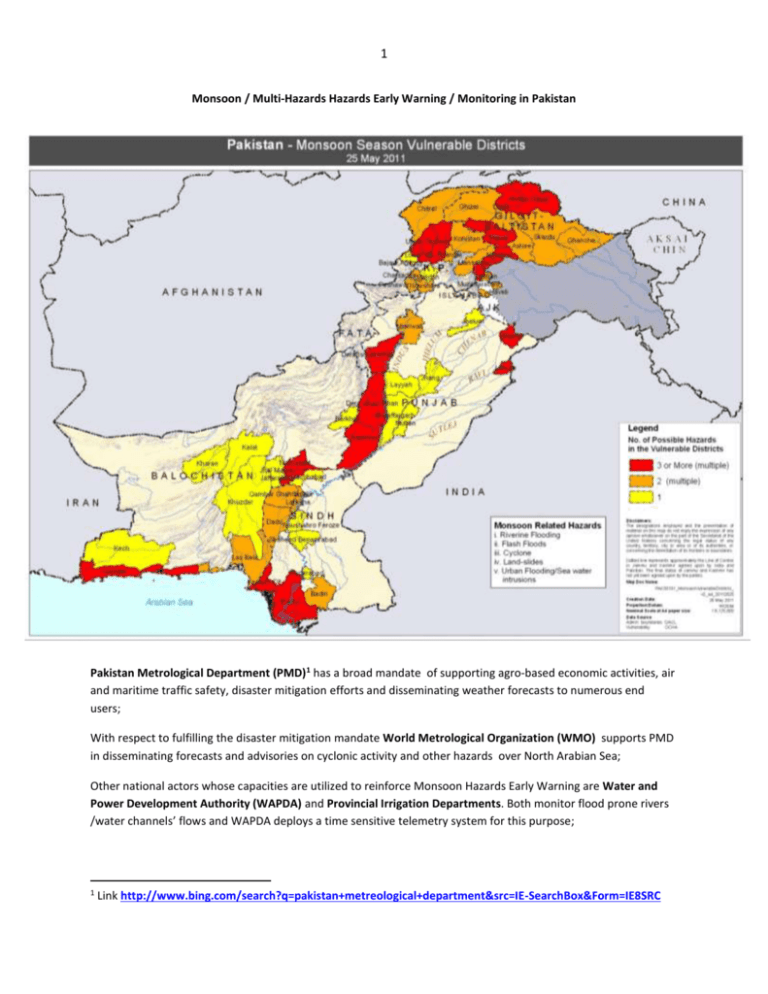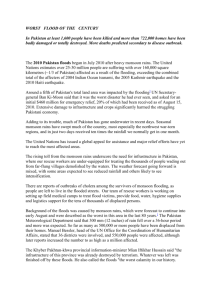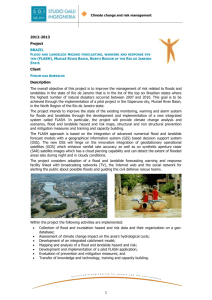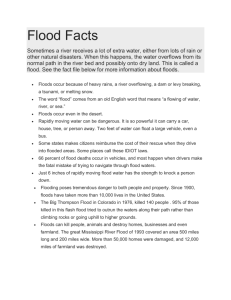Monsoon Hazards Early Warning in Pakistan
advertisement

1 Monsoon / Multi-Hazards Hazards Early Warning / Monitoring in Pakistan Pakistan Metrological Department (PMD)1 has a broad mandate of supporting agro-based economic activities, air and maritime traffic safety, disaster mitigation efforts and disseminating weather forecasts to numerous end users; With respect to fulfilling the disaster mitigation mandate World Metrological Organization (WMO) supports PMD in disseminating forecasts and advisories on cyclonic activity and other hazards over North Arabian Sea; Other national actors whose capacities are utilized to reinforce Monsoon Hazards Early Warning are Water and Power Development Authority (WAPDA) and Provincial Irrigation Departments. Both monitor flood prone rivers /water channels’ flows and WAPDA deploys a time sensitive telemetry system for this purpose; 1 Link http://www.bing.com/search?q=pakistan+metreological+department&src=IE-SearchBox&Form=IE8SRC 2 In addition Pakistan Space and Upper Atmosphere Research Commission (SUPARCO)2, maritime agencies like Pakistan Navy, Maritime Security Agency (MSA) and air space users like Pakistan Air Force also reinforce monsoon weather and impact monitoring efforts; Following devastating floods of 1992, national Flood Early Warning system was reinforced through creation of Lahore based Floods Forecasting Division, an affiliate organization of PMD. It is the national focal point for monsoon early warning dissemination and broadly its mandate covers: Dissemination of daily floods forecasts during the monsoon season3; and Flood situation reporting like disseminating data on flood levels in various rivers ; FFD based Riverine Floods Forecasting System (refer to the Organogram on page 3) benefits from the inputs of: Network of nation- wide weather forecasting radars; Doppler radars that provide quantified flood warning in the Kashmir catchment 4; Telemetric system which transmits real time inputs on flood quantums; Satellite coverage which includes indigenous capacity, support from Chinese and WMD satellite network; and Flood information received from India as part of Indus Water Treaty However, for tropical cyclone early warning PMD maintains Tropical Cyclone Warning Centre in Karachi and it is linked to WMO’s regional Warning Centre in New Delhi (India); Similarly PMD benefits for tsunami early warning from Japan Meteorological Agencies (JMA) and US Tsunami Early Warning Centre in Hawai; PMD also undertakes Drought and Seismological hazards monitoring; Brief Analysis of National Monsoon Hazards Forecasting System 2 Vulnerable regions with respect to riverine floods early warning are: Upper KP (along rivers Kabul and Swat), Gligit Baltistan (GB), Upper AJK and where Chenab enters Pakistan in eastern Punjab. Early Warning for major floods in these areas span from 6-18 hours; Flood early warning coverage of Kabul and Indus catchments in upper KP is relatively weak; There is no effective early warning system in place for flash floods which tend to occur country wide: across GB, upper KP, upper AJK, along Indus Right Bank through KP, Punjab and Balochistan. Only one telemetry based system is deployed to early warn Rawalpindi of flash floods along Leh Nullah 5; Past experiences affirm that accuracy of seasonal forecasts is tentative at best as accurate forecasts normally cover shorter periods: a fortnight or even less; Please note that PMD’s Monsoon Seasonal Forecast is anticipated before 10 June; However, past experiences affirm relatively more accurate tropical cyclone monitoring and land-fall predictions which facilitated proactive responses. SUPRCO’s services are utilized more for gauging disaster impact through satellite imagery. The official monsoon season in Pakistan spans 15 July to 15 September 4 Kashmir catchment mainly feeds the four eastern rivers: Jhelum, Chenab, Ravi and Sutlej. 5 Most of Islamabad constitutes its catchment 3 3 Flood Forecasting Division (FFD) Floods Early Warning Organogram Flood Early Warning Weather & Flood Radars Satellite Cover WAPDA Field Stations INDIA-IWT FED Agencies Armed Forces Telemetry FFD Lahore NDMA PDMA Provincial Irrigation Agencies Dept DCOs







